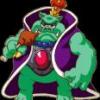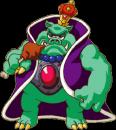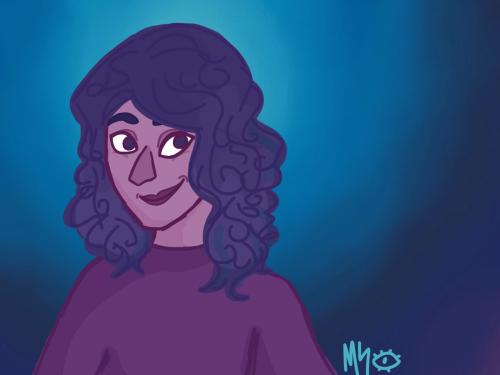
Zelda as Myth
#1

Posted 11 December 2011 - 02:43 AM
Manuscript 1: LoZ-AoL
This cycle is the simplest and earliest of the Zelda legends. None of the broader mythos is present here, and later traditions tend to re-state and embellish its events rather than incorporate the whole plot of these games into their arcs. Think of this as the earliest Arthur legends, where Arthur is some guy fighting off Saxons rather than the mythical hero-king he later became with the round table and Excalibur. Contains elements like Sleeping Zelda which have been essentially ignored by later traditions.
Manuscript 2: ALttP-LA
This cycle comes from a different author who sought to develop an origin story for Ganon. While not explicitly connected to the first manuscript, its basic plot is re-used. However, instead of continuing with AoL's plot, the author substitutes a story about Link going on an adventure to Koholint.
Manuscript 3: OoT-MM
This is an attempt to elaborate upon the Imprisoning War legend, and introduces concepts like the Golden Goddesses and almost all of the races. It becomes the template for all other manuscript traditions. Think of it like the Iliad and Odyssey which became the template for all epic poetry after them.
Manuscript 4: TWW-PH-ST
Attempts to write a sequel to Manuscript 3, and develops a long arc about the Great Sea. Probably written by a sea trader, with ST as a late addition. This manuscript ignores Manuscript 3's intent to tie into Manuscript 2. Due to the vastly growing manuscript traditions, this cycle makes explicit the assumption that there are multiple Links and Zeldas.
Manuscript 5: TP
Another sequel to Manuscript 3, using the time travel mechanics of OoT to explain its incompatibility with Manuscript 4. Implied to connect to Manuscript 2 as well.
Manuscript 6: TMC-FS-FSA
A separate cycle which uses elements of Manuscript 2 and Manuscript 3. The central elements of the Triforce and Master Sword are not used.
Manuscript 7: SS
A prequel to Manuscript 3 which uses elements of Manuscript 6. Adds meta-origin for multiple Links and Zeldas in order to clear up gaps and plot holes.
Manuscript 8: Oracles
A localized tradition to Holodrum and Labrynna, probably written soon after Manuscript 3, but similar in style to Manuscript 1.
#2

Posted 11 December 2011 - 05:37 AM
#3

Posted 11 December 2011 - 10:52 AM
What connections I interpreted as being important and the distinction I made between spiritual and chronological connections were very much made up on the spot when I made this a few weeks ago, but this is basically how I see the Zelda series these days. The DS games are missing because I haven't actually played them yet. And yes, three games link into the 'Zelda mythos' title. That's how I roll.
#4

Posted 11 December 2011 - 03:10 PM
#5

Posted 11 December 2011 - 03:32 PM
Lo and behold, you've described how I pretty much see the series ever since I started thinking of it in a mythological, cyclical sense... My obessesions with Eastern Philosophy and Battlestar Galactica have a lot to do with that...I think that if one views the Zelda games in terms of a "manuscript tradition" rather than a "timeline," a lot of the plot holes tend to make more sense. If this is a cycle of stories with common themes and only a loose chronological connection, then stuff like the discrepancies between games make a lot more sense. I know that this is similar to the "Literal Legend/No timeline" cop-out that some people use, and I will still stick with my timeline for what I think the developers intend, but this is an interesting thought to entertain.
Manuscript 1: LoZ-AoL
This cycle is the simplest and earliest of the Zelda legends. None of the broader mythos is present here, and later traditions tend to re-state and embellish its events rather than incorporate the whole plot of these games into their arcs. Think of this as the earliest Arthur legends, where Arthur is some guy fighting off Saxons rather than the mythical hero-king he later became with the round table and Excalibur. Contains elements like Sleeping Zelda which have been essentially ignored by later traditions.
Manuscript 2: ALttP-LA
This cycle comes from a different author who sought to develop an origin story for Ganon. While not explicitly connected to the first manuscript, its basic plot is re-used. However, instead of continuing with AoL's plot, the author substitutes a story about Link going on an adventure to Koholint.
Manuscript 3: OoT-MM
This is an attempt to elaborate upon the Imprisoning War legend, and introduces concepts like the Golden Goddesses and almost all of the races. It becomes the template for all other manuscript traditions. Think of it like the Iliad and Odyssey which became the template for all epic poetry after them.
Manuscript 4: TWW-PH-ST
Attempts to write a sequel to Manuscript 3, and develops a long arc about the Great Sea. Probably written by a sea trader, with ST as a late addition. This manuscript ignores Manuscript 3's intent to tie into Manuscript 2. Due to the vastly growing manuscript traditions, this cycle makes explicit the assumption that there are multiple Links and Zeldas.
Manuscript 5: TP
Another sequel to Manuscript 3, using the time travel mechanics of OoT to explain its incompatibility with Manuscript 4. Implied to connect to Manuscript 2 as well.
Manuscript 6: TMC-FS-FSA
A separate cycle which uses elements of Manuscript 2 and Manuscript 3. The central elements of the Triforce and Master Sword are not used.
Manuscript 7: SS
A prequel to Manuscript 3 which uses elements of Manuscript 6. Adds meta-origin for multiple Links and Zeldas in order to clear up gaps and plot holes.
Manuscript 8: Oracles
A localized tradition to Holodrum and Labrynna, probably written soon after Manuscript 3, but similar in style to Manuscript 1.
Not neccessarily. If you think about it, it gives you more choices. Instead of making just linear connections you can also draw parallels. It's like before only being able to move forward or back but now you can move side to side.Eh. I don't see it as being significantly different from the "Retold Legend" idea. Takes a lot of the fun out of it.
i posted this on zu several months ago. basically illustrates how i view the zelda continuity these days.
What connections I interpreted as being important and the distinction I made between spiritual and chronological connections were very much made up on the spot when I made this a few weeks ago, but this is basically how I see the Zelda series these days. The DS games are missing because I haven't actually played them yet. And yes, three games link into the 'Zelda mythos' title. That's how I roll.
You totally stole that idea from me!
...
#6

Posted 11 December 2011 - 03:41 PM
You totally stole that idea from me!
in my defence, i did warn you!
Edit: I consider TMC a spiritual prequel to the whole series because of the origin of Link's hat thing and all. But chronologically speaking it only has to deal with FS/FSA.
This is absolute awesome. I may have to steal it for my own purposes.I'll finally have a way to easily group MC primarily with the games it directly connects to, while acknowledging how it relates to the series as a whole.
#7

Posted 11 December 2011 - 03:41 PM
#8

Posted 11 December 2011 - 04:40 PM
You totally stole that idea from me!
in my defence, i did warn you!Edit: I consider TMC a spiritual prequel to the whole series because of the origin of Link's hat thing and all. But chronologically speaking it only has to deal with FS/FSA.
This is absolute awesome. I may have to steal it for my own purposes.I'll finally have a way to easily group MC primarily with the games it directly connects to, while acknowledging how it relates to the series as a whole.
The only difference now is that I'd consider SS as Ur-Myth to the series as a whole since it's basically has trace elements of every mythos in the Zelda series to the point I'm considering viewing the series as fragmented stories of the original story of Skyward Sword.
#9

Posted 11 December 2011 - 04:42 PM
Not neccessarily. If you think about it, it gives you more choices. Instead of making just linear connections you can also draw parallels. It's like before only being able to move forward or back but now you can move side to side.
...Which people did anyway.
#10

Posted 11 December 2011 - 06:35 PM
Not neccessarily. If you think about it, it gives you more choices. Instead of making just linear connections you can also draw parallels. It's like before only being able to move forward or back but now you can move side to side.
...Which people did anyway.
Only with TP and TWW in two ends of a split timeline, as far I know. Not many other parallel were made as far as strictly chonological-based timelines went. Maybe TWW and ALttP were compared since they both tie to OoT. When you look at it in a more mythological perspective, making parallel connections seems more natural than if you were looking at in a chapter-to-chapter strictly historical view. I'd say a mythological perspective is more fun in that respect as it opens more options.
#11

Posted 11 December 2011 - 06:45 PM
#12

Posted 11 December 2011 - 08:36 PM
#13

Posted 11 December 2011 - 09:27 PM
#14

Posted 11 December 2011 - 10:44 PM
While I think I'll always find it more entertaining to think of the series as a continuous story, I can certainly see the validity in looking at it this way. Really, SS kinda got me thinking about the literal-legend thing, the way the opening had more than a little in common with TWW's. The question I have is this: What does the Hyrule look like where these legends (or myths, if you prefer) exist?
However the current storyteller envisions it. There's just enough consistency to say they're all the same place, except for ST's which specfically states it's a different land entirely. I personal don't buy the theory that massive earthquakes, landslides, ect explain how Hyrule changes with each game. Most of those would entirely devastate a whole civilization, if not kill everyone outright. SS basically disproves this notion in Lanayru where you literally see two iterations of the same area from two different eras side by side. In thousands of years between Lanayru being a green, maritime cliffs and arid desert wasteland, the actual shape of the land doesn't really change that much, just the climate. And we're talking about a thousand years of time span. So I prefer to attribute any geographical inconsistencies between games as different storytellers just envisioning a Hyrule as "they imagine it." Kinda like how there's a dozen different versions of how people think Atlantis looked like with a enough specific details that everyone can agree on. In Hyrule case, I guess you could say Hyrule is a green valley surrounded by forests and red mountians beyond that. There's a desert to the west and a Lake fed by a waterfall somewhere close to civilization. It borders a sea though there may or may not be land to the north making it either an island or a huge peninsula. Or maybe it's landlocked like in TP. That's when details start to get fuzzy.
Edited by SOAP, 11 December 2011 - 10:50 PM.
#15

Posted 11 December 2011 - 10:59 PM
While I think I'll always find it more entertaining to think of the series as a continuous story, I can certainly see the validity in looking at it this way. Really, SS kinda got me thinking about the literal-legend thing, the way the opening had more than a little in common with TWW's. The question I have is this: What does the Hyrule look like where these legends (or myths, if you prefer) exist?
However the current storyteller envisions it. There's just enough consistency to say they're all the same place, except for ST's which specfically states it's a different land entirely. I personal don't buy the theory that massive earthquakes, landslides, ect explain how Hyrule changes with each game. Most of those would entirely devastate a whole civilization, if not kill everyone outright. SS basically disproves this notion in Lanayru where you literally see two iterations of the same area from two different eras side by side. In thousands of years between Lanayru being a green, maritime cliffs and arid desert wasteland, the actual shape of the land doesn't really change that much, just the climate. And we're talking about a thousand years of time span. So I prefer to attribute any geographical inconsistencies between games as different storytellers just envisioning a Hyrule as "they imagine it." Kinda like how there's a dozen different versions of how people think Atlantis looked like with a enough specific details that everyone can agree on. In Hyrule case, I guess you could say Hyrule is a green valley surrounded by forests and red mountians beyond that. There's a desert to the west and a Lake fed by a waterfall somewhere close to civilization. It borders a sea though there may or may not be land to the north making it either an island or a huge peninsula. Or maybe it's landlocked like in TP. That's when details start to get fuzzy.
yeah, pretty much all of this. one of the things i really don't get about elaborate theories to explain the geographical inconsistencies is that it basically boils down to people adding a load of new details to the series to explain away something which has no importance whatsoever to the stories.
#16

Posted 11 December 2011 - 11:03 PM
#17

Posted 11 December 2011 - 11:17 PM
#18

Posted 12 December 2011 - 10:07 AM

















